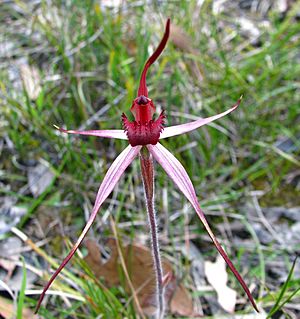Caladenia concolor facts for kids
The Caladenia concolor, also known as the crimson spider orchid, is a special plant. It belongs to the orchid family. This beautiful orchid grows only in the south-east of Australia. It is a ground orchid, meaning it grows in the soil. It has one slightly hairy leaf. It also grows one or two dark purplish-red flowers. These flowers are a bit hairy too.
Quick facts for kids Crimson spider orchid |
|
|---|---|
 |
|
| Caladenia concolor growing near "Fairy Park" | |
| Conservation status | |
| Scientific classification | |
| Genus: |
Caladenia
|
| Species: |
concolor
|
| Synonyms | |
|
|
Contents
What Does It Look Like?
The crimson spider orchid is a plant that grows from the ground. It is a perennial plant, meaning it lives for more than two years. It is also deciduous, so its leaves fall off each year. This plant has a special underground part called a tuber. It is like a small storage root.
Each orchid has one leaf. This leaf is long and narrow, like a spear. It can be about 8 to 15 centimeters (3-6 inches) long. The leaf is also about 8 to 10 millimeters (0.3-0.4 inches) wide. It has only a few hairs on it.
The orchid grows one or two flowers. These flowers can be up to 80 millimeters (3 inches) wide. They grow on a stem that can be up to 25 centimeters (10 inches) tall. The flowers are a dark purplish-red color.
Flower Parts
The flower has parts called sepals and petals. These are long and thin. They are about 25 to 45 millimeters (1-1.8 inches) long. They start wider at the bottom and become very thin. This thin part hangs down like a "tail." The tail is covered with tiny bumps called glands.
The petals are like the sepals but a bit shorter. The main part of the flower is called the labellum. It is shaped like an egg. The labellum is about 5 to 13 millimeters (0.2-0.5 inches) long. It is also 8 to 10 millimeters (0.3-0.4 inches) wide. It is dark purplish-red and curves downwards at its tip.
The sides of the labellum turn upwards. They have small teeth along their edges, up to 3 millimeters (0.1 inches) long. In the middle of the labellum, there are four rows of special bumps. These bumps are called calli and look like tiny feet.
This orchid flowers from September to November. People have said the flowers smell like a "hot motor." Others say they have a "distinctly mandarin-flavored smell."
How It Got Its Name
The crimson spider orchid was first officially described in 1928. A person named Robert D. FitzGerald wrote about it. He found a sample of the plant near Albury, Australia. His description was published in his book, Australian Orchids.
The scientific name concolor comes from a Latin word. It means "uniformly colored." This name describes the orchid's consistent color.
There are two types of crimson spider orchids. They are called Bethungra spider orchid and Burrinjuck spider orchid. Scientists think these might be described as new species in the future.
Where It Lives
The crimson spider orchid grows in special places. It likes granite ridges and slopes. These areas have dry, open forests. You can find it in northern Victoria and southern New South Wales.
In Victoria, it is found in two places. These are near Beechworth and Chiltern. In New South Wales, there are three groups of these orchids. They grow on private land near Bethungra. They are also in the Burrinjuck Nature Reserve. Another group is in the Nail Can Hill Reserve near Albury. The orchids near Bethungra and Burrinjuck might become new species names later.
Protecting This Orchid
The crimson spider orchid is a rare plant. It is listed as "Endangered" in New South Wales. This means it is at high risk of disappearing. It is also "Vulnerable" under a national law. This means it faces a high risk of becoming endangered.
There are not many of these plants left. Each group has only a few hundred individual plants. Many things threaten the orchid's survival. Its home is being lost or changed. Weeds are also growing where the orchids live. Animals like livestock and rabbits eat the plants.
Scientists are working to help save this orchid. They have successfully grown seeds of the plant. They use a special fungus called mycorrhiza to help the seeds grow. There are plans to plant these new orchids back into the wild.


